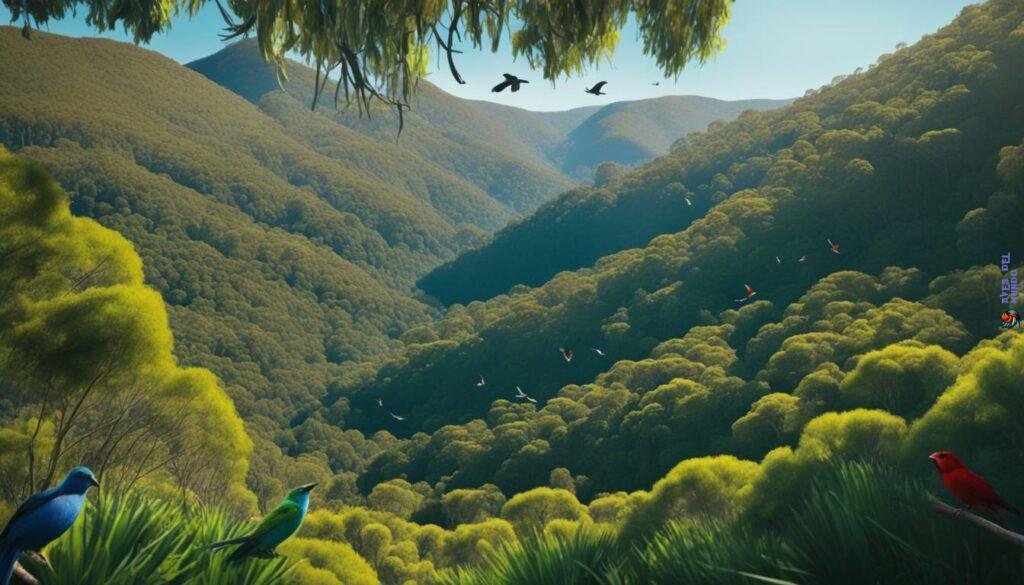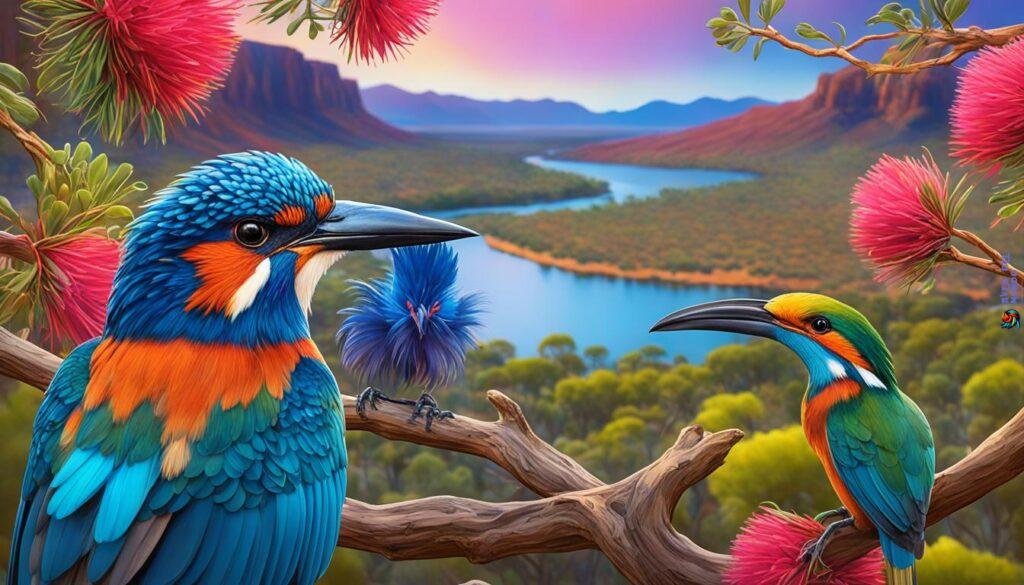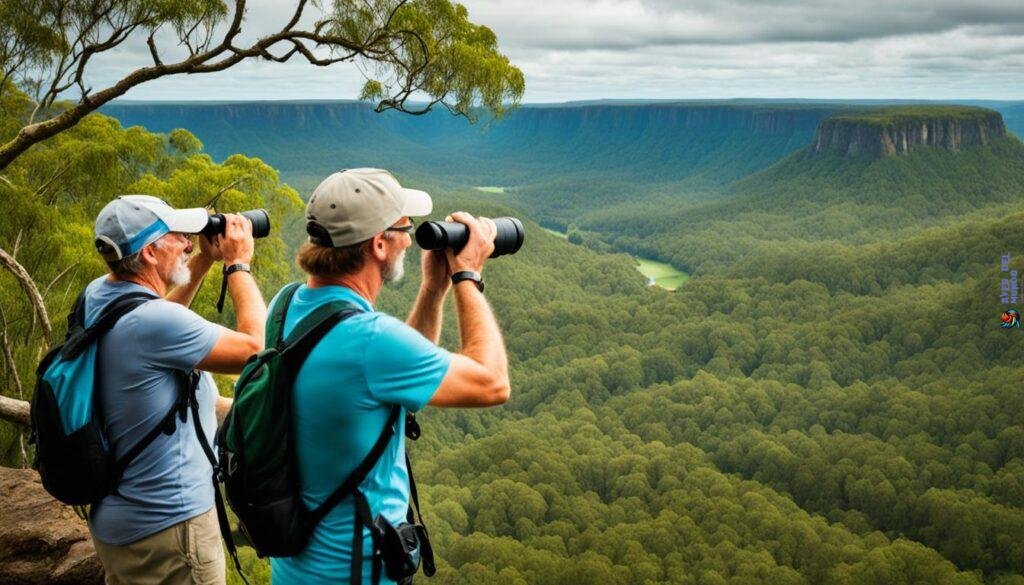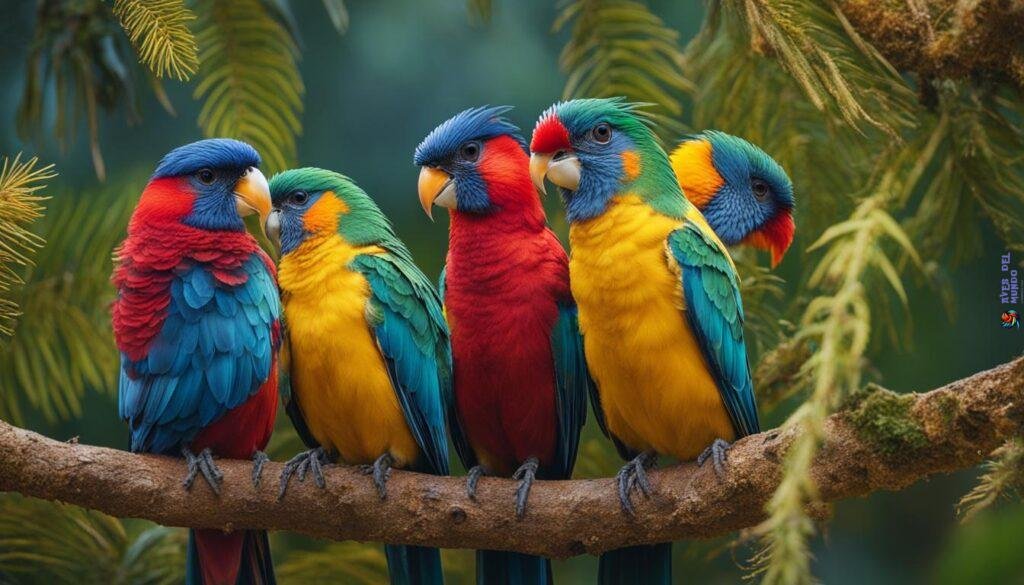Did you know that Australia is home to over 900 species of birds?
From the vibrant plumage of parrots to the majestic flight of eagles, Australian birds captivate the imaginations of birdwatchers and nature enthusiasts around the world. With its diverse landscapes and unique ecosystems, this vast country offers an unparalleled birdwatching experience.
In this guide, we will take you on a journey to explore the native Australian bird species, their habitats, and the best birdwatching locations across the continent. Whether you’re a seasoned birdwatcher or a beginner, Australia’s avian wonders are waiting to be discovered.
The Importance of Australia’s Bird Species
Australia is home to a wide range of unique bird species, many of which are found nowhere else in the world. The country’s isolation and varied ecosystems have contributed to the evolution of distinct native Australian birds. From iconic species like the emu and the kookaburra to colorful parrots and cockatoos, Australian birds are a vital part of the country’s biodiversity.
The diverse birdlife in Australia plays a crucial role in maintaining the ecological balance of its ecosystems. These birds serve as pollinators, seed dispersers, and pest controllers, contributing to the overall health of the environment. They also play a significant role in the cultural heritage of indigenous communities, who have long relied on their presence and knowledge of their behaviors for sustenance and storytelling.
«Australia has one of the highest rates of avian endemism in the world, with more than 300 bird species found only within its boundaries,» says Dr. Jane Wilson, an ornithologist and expert in Australian bird species. «These unique bird species are not only important from a conservation standpoint, but they also attract birdwatchers and nature enthusiasts from around the globe.»
«Australian birds are not just visually stunning; they also exhibit remarkable adaptations to their specific habitats,» Dr. Wilson explains. «From the underground nesting habits of the Australian brush turkey to the breeding displays of the superb lyrebird, these birds showcase nature’s incredible diversity and evolution.»
The conservation of native Australian birds and their habitats is crucial for ensuring their long-term survival. Ongoing efforts by conservation organizations, researchers, and governments are aimed at protecting vulnerable bird species and preserving their natural environments.

Bird Migration in Australia
Migration is a fascinating phenomenon among birds, and Australia serves as both a stopover and breeding ground for many migratory species. Each year, thousands of birds journey to and from Australia, following specific migration routes. Coastal areas, wetlands, and national parks are hotspots for bird migration, providing ample opportunities for birdwatchers to witness and study these incredible journeys.
During migration, birds undertake long-distance flights fueled by their instinctual drive to find suitable breeding grounds, forage for food, and escape harsh weather conditions. Australia’s diverse landscape and favorable climate make it an ideal destination for numerous bird species.

Coastal areas play a crucial role in bird migration, as they provide essential rest stops and feeding grounds for migratory birds. Wetlands, such as the Ramsar-listed Kakadu National Park in the Northern Territory and the East Asian-Australasian Flyway of Western Australia, attract migratory species, including shorebirds and waterfowl.
National parks, such as the Great Barrier Reef Marine Park and the Daintree Rainforest in Queensland, offer diverse habitats that support both resident and migratory birds. These protected areas provide crucial resources, including nesting sites, food sources, and shelter, making them vital for migratory species.
To illustrate the significance of bird migration in Australia, here’s a table showcasing some common migratory birds and their migration patterns:
| Common Bird Species | Migration Pattern | Main Breeding Grounds |
|---|---|---|
| Australian Pratincole | Seasonal Migration | Central and Northern Australia to Southeast Asia |
| Pacific Golden Plover | Long-Distance Migration | Siberia and Alaska to Australia and New Zealand |
| Eastern Curlew | Long-Distance Migration | Siberia and Alaska to Australia and Southeast Asia |
| Latham’s Snipe | Seasonal Migration | Japan and Siberia to Australia and the Pacific Islands |
Understanding bird migration patterns is essential for conservation efforts, as it helps identify critical habitats and areas of concern. By studying migratory birds and the challenges they face, researchers and conservationists can work towards preserving these vital ecosystems and ensuring the survival of both resident and migratory bird species.
Birdwatching Hotspots in Australia
Australia is truly a paradise for birdwatching enthusiasts, offering a plethora of hotspots where you can immerse yourself in the vibrant world of bird species. From the diverse wetlands of Kakadu National Park in the Top End to the lush rainforests of Queensland and the breathtaking rugged gorges of the Northern Territory, each region boasts its own unique birdlife.
If you’re drawn to coastal ecosystems, the Great Barrier Reef is a must-visit, teeming with both marine and avian life. Tasmania’s tall forests provide a haven for a variety of bird species, while the Flinders Ranges in South Australia showcase the stunning beauty of arid-adapted birds.
Whether you’re an experienced birdwatcher seeking rarities or a first-time enthusiast eager to spot iconic Australian birds, these hotspots guarantee an unforgettable birdwatching adventure.
Get ready to witness the vibrant plumage, melodic songs, and fascinating behavior of Australia’s feathered residents in their natural habitats.

Key Birdwatching Hotspots in Australia:
- Kakadu National Park: A wetland haven in the Top End, where you can spot waterbirds, raptors, and unique species like the Gouldian Finch.
- Queensland Rainforests: Explore the ancient rainforests of Queensland to see colorful parrots, elusive owls, and other rainforest-dwelling birds.
- Northern Territory Gorges: Discover the rugged beauty of the Northern Territory’s gorges and encounter birds like the spinifex pigeon and crimson chat.
- Great Barrier Reef: Dive into the world of seabirds and shorebirds around the Great Barrier Reef, including majestic frigatebirds and white-bellied sea eagles.
- Tasmania’s Tall Forests: Wander through Tasmania’s towering forests and encounter endemic species like the Tasmanian Thornbill and Forty-spotted Pardalote.
- Flinders Ranges: Explore the arid landscapes of the Flinders Ranges and spot birds adapted to the harsh desert environment, such as the Major Mitchell’s Cockatoo and the elegant Spinifexbird.
Plan your birdwatching adventure in Australia, and let the remarkable beauty of its bird species captivate you.
Essential Tools for Birdwatching in Australia
When embarking on your birdwatching adventure in Australia, having the right tools is crucial for an immersive and rewarding experience. Here are some essential tools that will enhance your birdwatching and bird photography in Australia:
- Binoculars: A good pair of binoculars is essential for observing birds from a distance. Look for binoculars with a wide field of view and good magnification to capture the intricate details of bird plumage.
- Australian Bird Field Guide: Invest in a field guide specific to Australian birds to accurately identify the species you encounter. A comprehensive guide will provide information on bird behavior, distinctive features, and distribution maps.
- Camera: Capturing those memorable moments of Australian bird species requires a reliable camera. Choose a camera with a telephoto lens to get close-up shots of birds in their natural habitats. Practice different photography techniques, such as adjusting shutter speed and aperture, to achieve stunning bird photography results.
- Bird Call Identifier: Learning to identify bird calls and songs adds another dimension to your birdwatching experience. Download a bird call identifier app or carry a pocket-size guidebook to help you recognize the unique vocalizations of Australian birds.
These essential tools will equip you with the means to fully immerse yourself in the beauty of Australian birds and capture incredible moments through bird photography. Remember to respect the birds and their habitats, maintain a safe distance, and adhere to any specific rules or regulations set by national parks or protected areas.
Quote:
“Having the right tools, such as binoculars, a field guide, and a camera, can turn a casual birdwatching trip into an unforgettable experience. Australia’s diverse birdlife awaits your discovery!”
Get ready to embark on your birdwatching journey in Australia armed with the essential tools, and prepare to be amazed by the captivating avian wonders that await you.

Notable Australian Bird Species
Australia is home to a wide range of native bird species, each with its own unique characteristics and charm. Whether you’re an avid birdwatcher or simply appreciate the beauty of nature, these notable Australian birds are sure to captivate your attention.
1. Emu
 The emu is the largest bird in Australia and the second-largest bird in the world. With its long legs, distinct beak, and grayish-brown feathers, the emu is an iconic symbol of the Australian outback. Found in various habitats across the country, this flightless bird is known for its powerful running abilities and unique mating rituals.
The emu is the largest bird in Australia and the second-largest bird in the world. With its long legs, distinct beak, and grayish-brown feathers, the emu is an iconic symbol of the Australian outback. Found in various habitats across the country, this flightless bird is known for its powerful running abilities and unique mating rituals.
2. Kookaburra
The kookaburra is a well-known Australian bird with a distinctive laughing call that echoes through the treetops. This iconic member of the kingfisher family has a stout body, a large head, and a strong beak. With its bold plumage and predatory nature, the kookaburra is a fascinating bird to observe in the wild.
3. Rainbow Lorikeet
The rainbow lorikeet is a colorful parrot native to Australia. With its vibrant plumage, which includes shades of green, blue, yellow, and red, this bird is a true delight to behold. Rainbow lorikeets are highly active and social birds that congregate in large flocks, often creating a beautiful spectacle in the sky.
4. Gouldian Finch
The Gouldian finch, also known as the rainbow finch, is a small but stunning bird that inhabits the northern regions of Australia. Renowned for its vividly colored plumage, the Gouldian finch exhibits a captivating mosaic of black, yellow, green, and red feathers. Sadly, due to habitat loss and capture for the pet trade, this finch is classified as endangered.
These are just a few examples of the many notable bird species found in Australia. Each region of the country boasts its own unique set of endemic birds, making birdwatching in Australia an incredibly rewarding and diverse experience.
| Species | Description |
|---|---|
| Emu | The largest bird in Australia and the second-largest bird in the world. Known for its distinctive appearance and powerful running abilities. |
| Kookaburra | A well-known Australian bird with a distinctive laughing call. Recognizable by its stout body and large head. |
| Rainbow Lorikeet | A colorful parrot native to Australia. Exhibits vibrant plumage in various shades. |
| Gouldian Finch | A small, endangered finch with stunning multicolored plumage. Found primarily in the northern regions of Australia. |
Conservation Efforts for Australian Birds
Many Australian bird species are facing significant threats such as habitat loss, climate change, and introduced predators. To protect and preserve these unique bird species and their fragile ecosystems, conservation organizations and government agencies in Australia have taken proactive measures.
Efforts such as land conservation, habitat restoration, and public awareness campaigns are crucial for ensuring the survival and well-being of native Australian bird species. These initiatives aim to address the primary causes of population decline and create sustainable environments for bird populations to thrive.
Conservation organizations work closely with scientists, local communities, and policymakers to develop strategies that protect critical habitats and implement conservation programs. These initiatives actively involve birdwatchers, researchers, and volunteers who contribute their time and expertise to monitor bird populations and support conservation efforts.
The successful conservation of Australian bird species depends on the collective efforts of individuals, communities, and organizations committed to preserving the country’s natural heritage.
«The natural world is the most important asset we have. We should cherish and protect it for future generations.»
– David Attenborough
Australian Birds Conservation Programs
A number of conservation programs have been established to address the specific challenges faced by different bird species in Australia. These programs focus on key areas such as:
- Habitat protection and restoration
- Species reintroduction and translocation
- Education and public outreach
- Research and monitoring
Through these programs, efforts are made to safeguard critical habitats, promote sustainable land use practices, and raise awareness about the importance of biodiversity conservation.
The Threats to Australian Birds
Australian bird species face several threats that endanger their survival:
- Habitat Loss: Urbanization, land clearing for agriculture, and deforestation are major contributors to habitat loss, resulting in the fragmentation and degradation of vital bird habitats.
- Climate Change: Rising temperatures, changing rainfall patterns, and extreme weather events pose significant challenges to bird populations, affecting their breeding cycles, feeding habits, and overall survival.
- Introduced Predators: Feral animals such as foxes, cats, and rats, introduced to Australia, have had detrimental effects on native bird populations by preying on eggs, chicks, and adult birds.
These threats, combined with other factors like pollution and human disturbance, underscore the urgent need for conservation efforts to mitigate the impact on Australia’s unique bird species.
Successful Bird Conservation Stories
The collective efforts of conservation organizations, researchers, and passionate individuals have led to several success stories in Australian bird conservation. Notable achievements include:
- The recovery of the Orange-bellied Parrot, one of the world’s most endangered birds, through dedicated captive breeding and habitat management programs.
- The restoration of wetlands and ecosystems in key bird habitats, providing essential feeding and breeding grounds for various waterbird species.
- Managing and controlling invasive species to protect vulnerable bird populations and promote the recovery of native species.
- Engaging local communities in bird conservation through education programs and citizen science initiatives.
These success stories demonstrate the positive impact of targeted conservation actions and highlight the importance of preserving Australia’s bird species for future generations.
| Threat | Conservation Effort | Impact |
|---|---|---|
| Habitat Loss | Land conservation and habitat restoration programs | Preserving critical bird habitats and promoting biodiversity |
| Climate Change | Research and monitoring of bird populations | Understanding the effects of climate change and developing adaptive strategies |
| Introduced Predators | Control and management of feral animals | Protecting native birds from predation and supporting population recovery |
Australia’s conservation efforts for bird species are vital for the protection of its unique avian biodiversity and the long-term ecological health of its diverse ecosystems.

Bird Photography Tips in Australia
Capturing stunning images of Australian birds requires the right equipment, patience, and an understanding of bird behavior. With Australia’s diverse birdlife, you have plenty of opportunities to hone your bird photography skills. Here are some tips to help you achieve success:
- Research bird behavior: Before heading out to photograph birds, familiarize yourself with their habits and habitats. This knowledge will enable you to anticipate their movements and capture them in their natural environment.
- Choose the right camera settings: Set your camera to a fast shutter speed to freeze the motion of birds in flight or to capture their quick movements. Use a wide aperture to create a shallow depth of field, isolating the bird from its background.
- Find the best lighting conditions: Soft, diffused lighting is ideal for bird photography. Golden hours, early in the morning or late in the afternoon, provide warm and beautiful light. Avoid harsh midday sunlight, as it can cast unflattering shadows.
- Use camouflage and be patient: Birds can be skittish, so it’s essential to blend into your surroundings and minimize any disturbances. Use natural colors and patterns to camouflage yourself and be prepared to wait quietly for the perfect moment to capture your shot.
- Experiment with composition: Explore different angles and compositions to create visually interesting images. Try capturing birds in flight, perched on branches, or interacting with their environment. Don’t be afraid to experiment and think outside the box.
Remember, bird photography requires practice and perseverance. Take the time to observe and appreciate the beauty of Australian birds while honing your skills. With dedication and a bit of luck, you’ll capture breathtaking images that showcase the incredible avian diversity found in Australia.

Recommended Camera Equipment for Bird Photography:
| Equipment | Description |
|---|---|
| Telephoto Lens | A long focal length lens (300mm or more) helps you get close-up shots of birds without disturbing them. |
| Tripod | Stabilizes your camera and lens, allowing for sharper images, especially in low-light conditions. |
| Bean Bag or Gimbal Head | Provides additional stability when shooting handheld or from a tripod. Helps reduce camera shake. |
| Camera Bag | Protects and organizes your gear while keeping it easily accessible during your bird photography outings. |
| Memory Cards and Backup | Carry extra memory cards to ensure you have enough storage space. Consider backing up your photos regularly. |
| Extra Batteries | Always have spare batteries on hand to avoid missing out on memorable bird photography opportunities. |
Popular Birdwatching Events and Festivals in Australia
Immerse yourself in the vibrant birdwatching community of Australia by attending one of the many exciting birdwatching events and festivals held throughout the year. These gatherings provide the perfect opportunity to connect with fellow birdwatchers, learn from experts, and delve deeper into the fascinating world of Australian birds.
One popular event not to be missed is the Australian Bird Fair, a prestigious gathering that showcases the diverse avian species found across the country. Attend informative presentations, browse exhibits, and participate in workshops to enhance your birdwatching skills and knowledge.
If you are up for a thrilling challenge, the Twitchathon is an exciting event where teams compete to record the most bird species seen or heard within a set period of time. Test your bird identification skills and experience the thrill of a friendly competition in the beautiful Australian wilderness.
The Aussie Backyard Bird Count is a citizen science initiative that encourages birdwatchers of all levels to contribute valuable data by observing and recording the birds they spot in their local areas. Join thousands of participants across the country in this nationwide survey, helping scientists and conservation organizations to monitor bird populations and make informed decisions for their protection.
Image: Australian Bird Fair

«Attending birdwatching events and festivals in Australia allows you to connect with like-minded enthusiasts, expand your knowledge, and contribute to conservation efforts through citizen science initiatives. Don’t miss out on these incredible opportunities to celebrate the extraordinary avian diversity of Australia!»
Resources for Birdwatching in Australia
For avid birdwatching enthusiasts, Australia offers a plethora of resources to enhance your birdwatching experience. Whether you’re a beginner or a seasoned birder, these resources provide valuable information, guidance, and opportunities to observe the diverse avian life found throughout the country.
Birdwatching Field Guides
Field guides specific to Australian birds are essential tools for identifying and learning about the rich bird species that inhabit the country. These guides contain detailed descriptions, illustrations, range maps, and helpful identification tips. Some recommended field guides for birdwatching in Australia include:
- The Australian Bird Guide by Peter Menkhorst
- Simpson and Day’s Field Guide to the Birds of Australia by Ken Simpson and Nicholas Day
- A Field Guide to the Birds of Australia by Graham Pizzey and Frank Knight
Birdwatching Websites and Forums
Online birdwatching websites and forums are valuable resources for connecting with fellow birdwatchers, sharing sightings, discussing bird behavior, and seeking advice. These platforms provide a wealth of information on bird species, locations, and birdwatching tips. Some popular birdwatching websites and forums in Australia include:
- Australian Birdlife – the official website of BirdLife Australia, featuring bird guides, sightings database, and conservation initiatives.
- Birds in Backyards – an online citizen science project that encourages community involvement in birdwatching and bird monitoring.
- BirdForum – a global birdwatching forum where you can connect with experienced birders and seek advice on birdwatching in Australia.
Regional Birding Clubs
Joining a local birding club is an excellent way to network with fellow birdwatchers, participate in guided bird walks, and attend informative workshops. These clubs often organize regular birdwatching outings to various locations, providing opportunities to learn from experienced birders and discover new bird species. Some notable birding clubs in Australia include:
- Birds Queensland – a leading birding organization in Queensland that conducts field trips and promotes bird conservation.
- Birds Australia – a national organization dedicated to the study and conservation of Australian birds, with local branches across the country.
- Birdlife Australia – a prominent bird conservation organization that offers membership benefits, including access to local bird clubs and events.
National Parks and Conservation Areas
Australia boasts a vast network of national parks and conservation areas, many of which offer guided bird walks, workshops, and educational programs. These protected areas provide an ideal habitat for a diverse range of bird species. Some national parks renowned for birdwatching in Australia include:
- Kakadu National Park, Northern Territory – home to an extensive array of birdlife, including rare species like the Gouldian Finch and the Rainbow Pitta.
- Lamington National Park, Queensland – famous for its lush rainforests and diverse bird species, such as the Regent Bowerbird and Albert’s Lyrebird.
- Great Otway National Park, Victoria – a haven for birdwatchers, featuring endemic species like the Rufous Bristlebird and the Powerful Owl.
These resources provide invaluable assistance and guidance to ensure a rewarding birdwatching experience in Australia. So grab your binoculars, consult your field guide, and embark on a birding adventure to discover the captivating avian wonders that await you in this beautiful country.

Birdwatching Etiquette in Australia
When engaging in birdwatching activities in Australia, it’s important to follow certain etiquette guidelines. By respecting the birds and their habitats, you can ensure a positive experience for both you and the birds you are observing.
Respect the Birds and Their Habitats
When birdwatching in Australia, remember that you are a guest in the birds’ natural environment. Keep a respectful distance and avoid disturbing their nesting areas. Maintain a quiet and calm demeanor to minimize any potential stress to the birds.
«Respecting the birds and their habitats is crucial for their well-being and conservation. By observing from a distance, you can enjoy their natural behaviors without causing unnecessary disruption.»
Follow Rules and Regulations
Many birdwatching locations in Australia, such as national parks and protected areas, have specific rules and regulations in place to protect the wildlife and their habitats. Make sure to familiarize yourself with these guidelines and follow them accordingly. This may include sticking to designated trails, refraining from feeding the birds, and avoiding the use of flash photography.
«By adhering to the rules and regulations set by national parks and protected areas, you can contribute to the conservation efforts and preservation of the diverse bird species in Australia.»
Minimize Disturbance
When observing birds, it’s important to minimize your impact and avoid any actions that may disturb or stress the birds. Avoid sudden movements, loud noises, or getting too close to their nesting areas. Keep in mind that you are entering their natural habitat and should take measures to ensure their well-being.
Share the Experience
Birdwatching is a wonderful activity to be shared with others. However, it’s important to be considerate of fellow birdwatchers and respect their space. If you encounter other birdwatchers, maintain a respectful distance and avoid disrupting their observations.
By following these birdwatching etiquette guidelines, you can contribute to the conservation efforts and preservation of the unique bird species in Australia. Respect for the birds and their natural habitats ensures a positive and sustainable birdwatching experience for everyone.

The Future of Birdwatching in Australia
Birdwatching in Australia is experiencing a surge in popularity, as more and more people become captivated by the beauty and diversity of native Australian birds. With its vast landscapes and unique ecosystems, Australia offers birdwatchers and nature enthusiasts a truly extraordinary experience.
As conservation efforts continue to gain momentum and awareness about the importance of native Australian birds grows, there is hope that future generations will embrace and protect these feathered wonders. By fostering a love and appreciation for birds, we can contribute to the preservation of their habitats and ensure their survival for years to come.
Birdwatching not only provides an opportunity to connect with nature but also offers valuable insights into the complex world of avian behaviors, migration patterns, and ecological interactions. It is a hobby that promotes environmental awareness, scientific study, and a deep appreciation for the natural world.

The Role of Citizen Science
In recent years, citizen science initiatives have played a significant role in advancing birdwatching and conservation efforts. By actively engaging birdwatchers of all levels of expertise, these initiatives collect valuable data about bird populations, distribution, and migration patterns. This information is vital for researchers and conservationists to formulate effective strategies for bird conservation.
Through citizen science programs, birdwatchers can contribute to scientific research by reporting their observations, participating in bird counts, and documenting bird behaviors. This collaborative approach ensures that everyone can contribute to our understanding of native Australian birds, regardless of their level of expertise or location.
Education and Awareness
To secure the future of birdwatching in Australia, it is essential to continue educating the public about the importance of native bird species and their habitats. By raising awareness about the ecological significance of birds and their roles as indicators of environmental health, we can inspire more people to engage in birdwatching and conservation efforts.
Education initiatives should target both children and adults, providing resources and opportunities for learning about native bird species, their habitats, and ways to protect them. By instilling a sense of wonder and appreciation for birds from an early age, we can cultivate a new generation of passionate birdwatchers and environmental stewards.
Collaboration and Conservation Efforts
The future of birdwatching in Australia relies on the collaboration between individuals, communities, conservation organizations, and government agencies. By working together, we can enact effective conservation measures, preserve crucial habitats, and address the various threats faced by native bird species.
«The diversity and splendor of Australia’s birdlife are unmatched, and it is our collective responsibility to safeguard these treasures for generations to come.»
Conservation efforts should focus on habitat restoration, the promotion of sustainable practices, and the establishment of protected areas. By implementing these measures, we can provide safe havens for birds to thrive and ensure that birdwatching remains a cherished pastime in Australia.
The Beauty of Birdwatching
Birdwatching allows us to step into the world of birds, witnessing their incredible behaviors, intricate plumage, and melodic songs. It is an activity that nurtures a deep connection with nature, fostering a sense of calm, curiosity, and awe.
By embracing birdwatching as a shared passion, we can forge connections with fellow bird enthusiasts, participate in birdwatching events and festivals, and contribute to the conservation of native Australian birds. Together, we can ensure that the future of birdwatching is bright and that the skies of Australia remain filled with the vibrant colors and melodious songs of its incredible avian inhabitants.
Get Started on Your Birdwatching Adventure in Australia
Whether you are a seasoned birdwatcher or a beginner, Australia offers a wealth of birdwatching opportunities. With its diverse landscapes and rich avian diversity, the country is a paradise for bird enthusiasts. From the vibrant parrots of the Queensland rainforests to the majestic raptors of the Flinders Ranges, there is something for every birdwatcher in Australia.
To make the most of your birdwatching adventure, it is essential to plan your visit to some of the country’s best birdwatching destinations. Kakadu National Park in the Top End is renowned for its wetlands and abundant birdlife, while the Great Barrier Reef provides a unique opportunity to witness seabirds in their natural habitat. Don’t forget to include Tasmania’s tall forests and the rugged gorges of the Northern Territory in your itinerary.
Equipping yourself with the necessary tools is key to a successful birdwatching experience. Make sure to bring a good pair of binoculars to observe birds from a distance without disturbing them. A bird field guide specific to Australian birds will help you identify different species and learn about their behaviors. And if you are passionate about capturing the beauty of Australian birds, don’t forget to pack your camera and telephoto lens to take stunning photographs.



